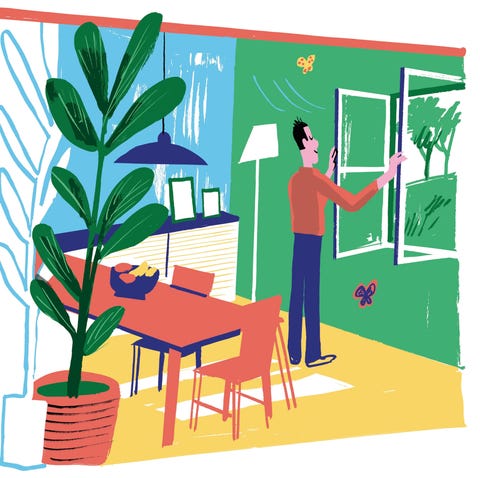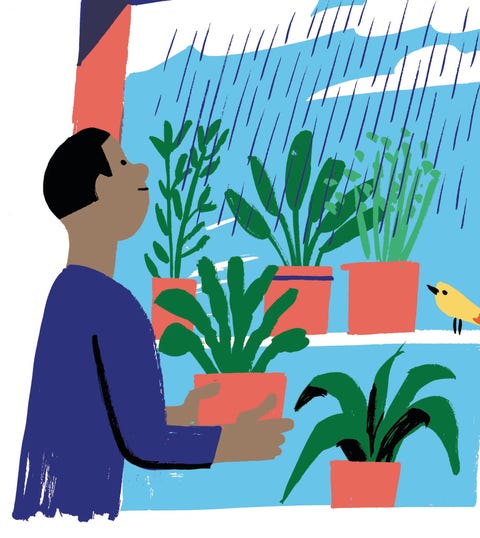Small steps to a greener future!BY KAITLIN PETERSEN AND MIRIAM PORTERPUBLISHED: JUN 9, 2022

On its face, implementing sustainable solutions can sound onerous, not to mention expensive. The good news is that creating a healthy oasis at home (and one that’s gentle on the planet, too) isn’t out of reach at all—and oftentimes, comes with a hefty cost savings thanks to reduced water and energy consumption. It’s time to make a change—or several.
Ready to start thinking green? Consider the realistic progress you can make today, what you can add tomorrow, and what to aim for in the future. Here’s a checklist to get you started as you tackle new projects around the house this season and beyond.

1. Insulate your house
Adding insulation to the walls of your home prevents warm air from leaking out in the winter. Eschew unsustainable sheep’s wool and harmful fiberglass for cotton, which can be made into thick batts for your walls. Other options include cork produced from the regenerating bark of a cork oak tree and cellulose from recycled newsprint and paper.
MORE FROM HOUSE BEAUTIFUL
Tour This Off-the-Grid Cabin in Bovina Center
Previous VideoPauseNext VideoUnmute
Current Time 1:17
Loaded: 100.00%
Remaining Time -0:40CaptionsPlay in full-screen
2. Opt for air sealing
Climate tech company Sealed reports the average home loses up to 50 percent of its heat through the top of the house thanks to under-insulated or unsealed attics. Air sealing a home, which also often includes upgraded insulation, makes temperature easier to regulate—whether you’re cooling or heating—and reduces energy usage by rendering climate-control efforts more effective.
3. Rethink your floor plan
Getting in touch with nature has plenty of health benefits, but optimizing your layout to take advantage of natural light is also an easy way to cut down on energy consumption (and save money). “Think about which rooms have the most sunlight and how you are utilizing them,” counsels New York designer Gala Magriñá. “Is there a better way to position your office or a breakfast nook so that they are in brighter light? Are your windows dirty, or are the window coverings broken so you don’t raise the shades?” Addressing such seemingly cosmetic fixes can have a positive impact on your energy consumption.
4. Install sustainable flooring
Reclaimed wood salvaged from old structures like barns or older buildings can be reused and kept from rotting in a landfill—a great way to save trees. It also helps improve air quality, since it’s not manufactured and doesn’t contain harmful VOCs (volatile organic compounds). Other sustainable flooring options include bamboo, cork, recycled glass, or recycled plastic bottles and tires that can be turned into carpets.
5. Use energy-efficient air conditioners
An energy-efficient air conditioner lowers your energy use and carbon footprint, not to mention your monthly bill! There are two types of units to consider: a split system and packaged central air system using ducts. (Not sure which one right for you? Check out our guide to choosing the best A/C for your home!)
6. Choose hydronic radiant heating
Hydronic radiant heating systems use water to heat a home instead of air. They are much more energy-efficient than forced air gas heating systems—not to mention a lot cheaper in the long run, Silver reveals. Plus, water-based systems reduce allergies, since “air is not being blown around, shooting dust particles,” he notes.

7. Invest in solar panels
Solar panels on your roof will source clean, pure energy directly from the sun, thereby reducing the use of fossil fuels. Though it can take some time to realize savings after the cost of installation (EcoWatch estimates that it takes about eight years to break even), solar power is one of the most proven ways to reduce household energy use. Ideally, you’ll need a sunny, south-facing roof that’s in good shape to support the panels. (You don’t need to replace your roof, but do make sure it has got a long life ahead of it.) While solar panels can be costly, many states offer incentives and subsidies for homeowners looking to make the switch.
8. Upgrade your power strips
Some electronics need the steady flow of power (your modem and router, for example); others, like printers or video game consoles, only require energy when in use. To avoid what’s called “phantom” power losses without the inconvenience and clutter of unplugging devices outright, opt for a conservation-minded solution like the Simply Conserve 7-Outlet Advanced power strip, which uses a mix of “control,” “always on,” and “switched” outlets so that the only devices pulling power are those in use.
 João Fazenda
João Fazenda
9. Opt for high-performance windows
Double-pane windows help keep cold air out in the winter and heat from the sun out in the summer. The high-performing windows can reduce the amount of heat escaping by up to 50%. For an extra environmentally-friendly touch, add sustainable blinds made from hemp or bamboo, or cotton curtains for a cozy and quiet bedroom.
Advertisement – Continue Reading Below
10. Install a smart thermostat
Corey Silver, a real estate broker at Re/Max in Toronto, suggests using a smart thermostat to monitor your energy consumption and control the climate of your home using Wifi and a phone app. “Simple digital thermostats can make a huge impact on your energy efficiency,” he says. “The ability to schedule your energy requirements based on peak and low usage times is a big advantage. Plus, it can all be done on your smartphone!”
11. Buy energy-efficient kitchen appliances
The Energy Star label was created to reduce greenhouse gas emissions and pollutants caused by inefficient use of energy and is backed by the U.S. Environmental Protection Agency (EPA). An Energy Star certified dishwasher can save almost 5,000 gallons of water annually. Other Energy Star certified appliances that use from 10% to 50% less energy include washers, dryers, refrigerators, boilers, furnaces, office equipment and electronics.
12. Choose eco-paints and wallpapers for your walls
Eco-friendly paints have lower levels of VOCs and emit fewer toxins, which reduces indoor air pollution. (The U.S. Environmental Protection Agency offers plenty of resources to help you pick the best sustainable paint or coating for your space.) If you opt for wallpaper instead, be sure to choose an eco-conscious brand like Spoonflower.
 João Fazenda
João Fazenda
13. Replace fluorescent light bulbs with LED bulbs
LED light bulbs consume up to 90% less energy, reduce your electricity consumption, and last longer. They can provide up to 10,000 hours of light, which equals two to four times more than many standard bulbs.
14. Connect your heating and cooling system to an app
When it comes to heating and cooling your home, “set it and forget it” is often the best, no-brainer approach, thanks to smart thermostats by brands like Nest, Ecobee, and Honeywell and apps like Flair or Ambi Climate. Magriñá recommends programming room temperatures on a schedule that matches a family’s everyday behaviors: “Smart home solutions are helpful for this because [they] put ensuring a healthy home on autopilot,” she says.
15. Keep electrical products for at least seven years
Electronic waste, or e-waste, encompasses any unwanted electronic equipment including old computers, televisions, smart phones, and used cables. These contain toxins such as mercury, lead, beryllium, and arsenic, which can be harmful to the environment and our health. Some parts that make up electronics (steel, copper, iron, glass) can be recovered and made into new items, so they must be disposed of properly—don’t throw them in the trash! To help reduce e-waste, keep electrical products for at least seven years, or donate them when you’re done.
6. Donate or sell old clothing
Spring cleaning is the perfect time to go through your closet Marie Kondo-style and get rid of items that no longer bring you joy. But instead of sending items to a landfill, drop them off at a thrift store, such as Goodwill or Housing Works.
17. Reduce clothing and accessory purchases or shop vintage
Buying vintage is better for the Earth (and your wallet!). Avoid fast fashion, which contributes huge amounts of pollution and chemicals. Keep clothes longer by washing them carefully, purchasing quality goods, and not buying items on a whim. And if your favorite hoodie has a hole, consider mending it yourself instead of tossing it.
18. Make your next mattress organic or sustainable
When it’s time for you to shop in a new mattress, invest in an eco-friendly option—i.e., one that doesn’t contain VOCs, which are often found in flame retardants, formaldehyde, plastics and polyurethane. And be sure to recycle your old mattress so it doesn’t end up in a landfill.

19. Stock your kitchen with healthy plant-based foods
Anita Krajnc—the Global Campaign Coordinator for Plant Based Treaty, a grassroots campaign designed to put food systems at the forefront of combating the climate crisis—believes that “everyone can play a role in tackling climate change” by substituting meat, dairy and eggs with plant-based alternatives. “Adopting a plant-based diet is by far the greatest action you can take to lower your carbon footprint,” she asserts.
After all, “the global food system is responsible for around a third of the world’s greenhouse gas emissions—not to mention, half of the planet’s habitable land is used to produce food,” she continues. “In addition, animal-derived products drive 70% of food-system emissions in high-income countries, and cattle grazing and growing animal feed takes up nearly 80% of global agricultural land, despite producing less than 20% of the world’s supply of calories.”
20. Patch up leaks
Check under your cabinets and you might be surprised to find evidence of small but steady drips. Also surprising? What a difference taking care of such little leaks can make on your water use. A quick audit of all water sources throughout the home (and fixing whatever you find!) preserves your belongings from mold and water damage and is good for the planet too.
21. Switch to dairy alternatives
“Eliminating dairy in favor of plant-based milks will prevent more methane from accumulating in the atmosphere,” says Krajnc. That said, there are dairy alternatives for milk, cheese, yogurt, butter, and ice cream readily available at grocery stores.
22. Start with Meatless Monday to eliminate meat and fish
“For fish and other animals such as cows, pigs and chickens, animal farming is the main cause of deforestation, species extinction, and ocean dead zones,” Krajnc reveals. “A more plant-based diet would help cut emissions and free up land to plant trees, [which can help] draw carbon dioxide out of the atmosphere. It’s a win for all life on Earth!”
23. Shop seasonal and locally sourced ingredients
Purchasing produce that’s in season and locally sourced helps curb emissions by shortening the distance food has to travel. Choose fruits and veggies with minimal packaging, and bring your own reusable mesh bags when grocery shopping.
24. Reduce kitchen plastics and single-use disposables
To help curb the rise of harmful microplastics, avoid using single-use plastic straws, cutlery, plates and cups. Opt for utensils made of reusable or recyclable materials such as stainless steel, glass, bamboo, wood, and straws made from 100% biodegradable items like corn, coconut, and agave. Instead of using plastic storage containers, invest in sustainable alternatives—and go the extra mile by skipping shrink-wrapped dishwasher tabs and plastic food packaging. (Zero-waste stores such as Precycle encourage customers to bring their own containers to fill, eliminating the need for plastic bags.)
25. Use all-natural cleaning products
Purchasing cleaning solutions free of chlorine bleach, ammonia, dyes, VOCs and harsh chemicals is not only better for your health, but also the water supply. Get creative and DIY with a recipe for natural homemade cleaners using baking soda and vinegar—add essential oils like lemon, lavender or tea tree oil to leave your home smelling fresh!


26. Install a low-flow toilet
Significantly reduce water use by replacing old water-guzzling toilets with more efficient ones. Standard toilets use up to seven gallons of water per flush, while low-flow toilets only use 1.6 gallons per flush. Just think about all the money you will save on your water bill—you’re practically flushing money down the toilet, if you don’t make the switch!
27. Invest in eco-friendly faucets and low-flow shower heads
In addition to turning off taps when brushing your teeth, save a sink’s water flow by up to 30% with a WaterSense-labeled faucet. Low-flow shower heads also decreases water consumption by at least 40%.
28. Shop zero-waste toiletries
Instead of buying plastic bottles of shampoo, lotions, creams, and conditioners, shop a zero-waste brand that offers package-free and refillable options, such as Fiils and The Body Shop.
29. Say no to plastic toothbrushes
A billion plastic toothbrushes are thrown away in the United States annually. Made with polypropylene plastic and nylon from fossil fuels, toothbrushes end up in waterways, gravely impacting marine life. To help curb this phenomenon, go for bamboo or wooden toothbrushes, or electric ones with replaceable heads.

30. Keep your car for longer (or consider an electrical car)
A study has shown that keeping your car even 10% longer before it gets sent to a scrapyard helps the environment. When it’s time to purchase a new vehicle, consider an electric car, which emits fewer greenhouse gases and pollutants into the air.
Tip: Walking, biking, public transportation, and car sharing are eco-friendly ways to reduce traffic and pollution in the city.
31. Use a rain barrel
Nurture your garden with repurposed rainfall from a backyard barrel instead of cranking up the hose. Not only does it save water, your plants will thank you—compared to tap water, rainwater contains more of the nitrogen, oxygen, and carbon dioxide that plants crave (and none of the chemicals that are in our water supply), giving your garden that lush, just-after-the-storm look again and again.
32. Garden with native plants
Work with nature by planting varieties that are native to your landscape. They’ll inherently be better suited to the environment, requiring less maintenance and less water. Not sure what to plant? The Extension Master Gardener program offers state-by-state resources that connect homeowners with local experts—including a hotline you can call to consult with volunteer gardeners who understand your climate best.
33. Consider lawn mowers that don’t use gas
Conventional gas-powered lawn mowers pack a serious pollution punch, even as much as some late model cars. Replace these oldies with a push lawnmower or an electric cordless one for a larger area. You could also consider mowing your lawn a bit less and go for the wild look. After all, it’s more fun to walk barefoot and feel the long soft grass under our feet, a natural gift from Mother Earth.
34. Plant a flower garden or grow your own veggies
Grow a sustainable organic garden in your backyard or join a community garden. Planting, growing, and harvesting your own food reduces carbon emissions and manages soil with compost for years to come. You can also help reduce plastic waste by harvesting veggies straight from your garden. (Add colorful, diverse flowers to attract bees and other pollinators, which are vital to the healthy production of crops.)
 João Fazenda
João Fazenda
35. Compost fruit and veggie waste
Turn kitchen scraps into fertilizer. After cooking, simply add food waste into a bin. Once it’s full, deposit its contents in your backyard as compost. If you don’t have a garden, check to see if your city has a green-bin program for fruit and veggie scraps to be collected and properly disposed of.
36. Skip pesticides and chemicals
Using pesticides can cause toxins to leak into streams, ponds, lakes, and wells, and can contaminate groundwater. Pesticides are not only dangerous to the environment and our health, but also pets and other wild animals. Alternative ways to keep critters at bay include companion planting, crop rotation, and keeping plants as healthy as possible so that they become naturally resistant to pests.
37. Grow herbs in small spaces
No backyard garden? No problem! Herbs such as mint, parsley, and basil grow easily on a balcony or windowsill.

Recent Comments